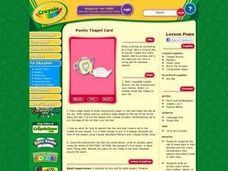Curated OER
Modern Living Made Easy
Students explore the history of the Industrial Revolution and how it preceded the development of many modern innovations. They research the history of many modern appliances and decide how they rely on these conveniences everyday.
Curated OER
Biography -People Who Have Made A Change In Our Lives
Young scholars create biographies about famous people. They use the library and the Internet to find pictures and information about the person they choose. They create a Kid Pix slide show and a poster.
Curated OER
Living in Italy
In this infinitive ESL worksheet, students will read a short passage. Students will then use different verb tenses to complete 8 questions about the story.
Curated OER
Living History: Documenting Our Senior Citizens Lives
Students investigate stereotypes by researching the elderly. In this senior citizen lesson, students interview elders in a rest home and video tape their experience. Students present their videos to their interview subjects after and...
Curated OER
Fish, Fish: Teaching K Students About Things That Live in the Sea
Students participate in activities designed to help them connect the words to the animals they are studying. Octopus is reinforced through playing a game, "Octopus Tag." Students play a cooperation game of passing bean bags from student...
Curated OER
The Most American Thing in America: The Chautauqua
Students explore the Chautauqua movement. For this Pennsylvania history lesson, students use primary documents to explore what the Chautauqua was and how it made a difference in the American way of life.
Curated OER
Living and Working Now and Long Ago
Students visit an online museum and storybook to examine what life was like for African Americans during and after the Civil War.
Curated OER
Living in Extreme Environments
High schoolers examine the characteristics of the ocean floor and the importance of of extreme environments. In this investigative instructional activity students use four methods to sample populations, gather, record and analyze data...
Curated OER
Taking Things Personally
High schoolers create a work of art calling attention to significant societal problems or social issues.
Baylor College
Needs of Plants
What better way to learn about plant life than by creating a class garden? Young botanists start with a brief discussion about radishes before planting seeds and watching them grow. To determine the importance of water, sunlight, and...
Baylor College
We Need Water
There's nothing quite like a glass of ice-cold, freshly squeezed lemonade. Lesson seven of this series explains how the water humans need to survive can come in many forms. Teach your class about how much water humans require every day...
Baylor College
Animals' Needs
Explore the wonderful world of earthworms as your class learns about the requirements of animal life. After building soda bottle terrariums, students observe worms over the course of a couple weeks, building an understanding that all...
ARKive
Adaptations to Arid Habitats
How do plants and animals survive in habitats with very little water? Explore arid ecosystems and the way their inhabitants have adapted with a lesson and science experiment. After kids listen to a presentation about adaptation, they...
New York State Department of Environmental Conservation
Adaptations – Designs for Survival
What's the difference between behavioral adaptations and physical adaptations? Learn about the various ways that organisms adapt to their environment with a worksheet about the creatures of the Hudson River.
Nuffield Foundation
Microbes Ate My Homework
Now you have a new excuse not to do your homework. A long-term experiment has learners explore cellulose-digesting enzymes. They simulate how paper breaks down in a compost bin. There's no need to blame your dog for eating your homework...
Curated OER
How Time Flies!
Students explore and document how things change over time by creating a layered-tab book with illustrations. They assess how the passing of time affects them, their family and the area in which they live. Each student makes a list of the...
Curated OER
Poetic Teapot Card
Students recognize the role of loved ones in their families and the many things their parents and others contribute to their lives. They write an acrostic poem about their mother, father, or other important person. They then make a...
Curated OER
Is it Alive?
Students watch a demonstration using Duco glue and water and try to determine if the "monster" shown is alive. After the demonstration, they discuss what characteristics make an organism "alive". They participate in a card sorting...
Curated OER
Migrant Families
Young scholars watch a video about migrant families identifying the responsibilities of the students and parents. They realize the importance of education in the lives of migrant families.
Curated OER
Flower Power: Kansas Quarter Reverse
Young scholars examine the Kansas quarter reverse and explore the basic needs and life processes of plants. They take a nature walk around the school and draw living and non-living things. In the classroom the sort the specimens...
Curated OER
Space Salad
Learners identify and analyze some of the similarities between Earth and Mars. Students identify why scientists believe that living things such as plants can live on Mars. Learners evaluate each of the Growing Space modules identify in...
Curated OER
"Chips" Off the Old Block?
Students study using analogies between common items or occurrences and science concepts. They use the analogy of cookie recipes to that of the DNA "recipes" for living things to help us explain more about mutations.
Curated OER
Yellowstone Wolves
Students use the Internet to explore relationships between habitats and species (specifically the gray wolf and those species with which it must coexist) as well as the effect of physical and human forces on living things and their...
Curated OER
C. B. Atlas Animations: Temperature Experiments
Students investigate cooling rates of shallow and deep water, analyze Chesapeake Bay temperature information, and interpret effects of temperature variations on living organisms.

























